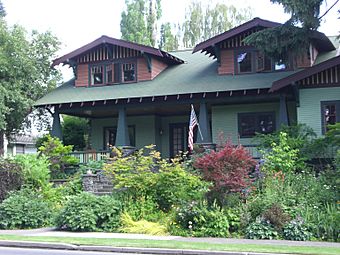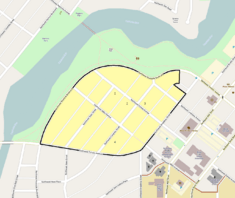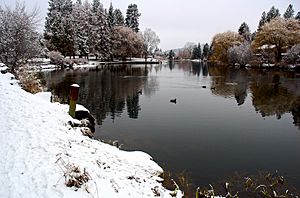Drake Park Neighborhood Historic District facts for kids
Quick facts for kids |
|
|
Drake Park Neighborhood Historic District
|
|

Residence on Riverside Boulevard in 2008.
|
|

The historic district boundaries in Bend.
|
|
| Location | Bend, Oregon, USA |
|---|---|
| Built | 1910–1954 |
| Architect | J.W. Dimick and David C. Lewis |
| Architectural style | American Craftsman and 13 other styles |
| NRHP reference No. | 05000380 |
| Added to NRHP | June 3, 2005 |
The Drake Park Neighborhood Historic District is a special area in Bend, Oregon. It's right next to Drake Park and close to the city's old downtown. This neighborhood is famous for its many different styles of homes. It also played a big part in how Bend grew. Because of its unique buildings and history, the area was added to the National Register of Historic Places in 2005.
Where is the Drake Park Historic District?
The Drake Park Neighborhood Historic District is located in Bend, Oregon. It covers 17 city blocks. There are 83 individual home lots within its borders. The district is bordered by Riverside Boulevard on the north and west. This street runs along Drake Park. Tumalo Avenue is on the south side. Broadway Street is to the southeast. Franklin Avenue marks the northeast corner.
The district is about 3,623 feet (1,104 meters) above sea level. The land is mostly flat. It slopes gently towards the west. The Deschutes River flows through Drake Park nearby. You'll see many large Ponderosa Pine trees here. Many walls and other landscape features are made from local basalt stone.
A Look Back: History of the Neighborhood
In 1910, a man named Alexander M. Drake owned the land. He divided it into lots for homes. This area is now the Drake Park Neighborhood Historic District. The streets were laid out south of a curving road. This road followed the Deschutes River. Back then, a lot cost between $100 and $250. This would be about $3,300 to $8,300 in today's money.
In 1921, 11 acres (45,000 square meters) along the river were sold. This land became Drake Park. In the same year, State Street was paved. It was the third street in Bend to get pavement.
These home lots were very popular. They were close to Drake Park. Many homes also had great views of the Cascade Mountains. The neighborhood was just one block from downtown Bend. This meant the city hall, library, and churches were easy to walk to. It was also close to the big lumber mills. Because of this, the Drake Park district quickly became the top choice for Bend's most important business people.

Over the years, many important people lived here. They were business owners and community leaders. They helped Bend grow into a major center for central Oregon. These residents included owners of lumber mills. They also owned downtown shops and hotels. Many mayors and county leaders also lived in the neighborhood.
Most of the homes were built between 1910 and 1954. Only three houses were built outside this time. The homes in the Drake Park neighborhood show how Bend grew. The city went from 536 people in 1910 to over 11,000 by 1950. This growth and the unique homes led to the neighborhood being listed on the National Register of Historic Places in 2005.
Architectural Styles in the District
There are 110 important buildings in the Drake Park Neighborhood Historic District. These are on 83 home lots. The area has many different types of architecture. It has kept its original look very well. About 81% of the homes add to its historic value.
Most houses built from 1910 to 1919 are American Craftsman style homes. In the early 1920s, some American Colonial style homes were built. But Craftsman homes stayed popular. After 1925, other styles appeared. These included Tudor, English Cottage, Cape Cod, Dutch Colonial, and Spanish Villa designs.
Few homes were built in the 1930s. Those that were showed different tastes. In the 1940s, people liked more modern designs. The last two historic homes were built in the 1950s. One is a California Ranch style. The other is a modern house built after the war. Since 1954, the neighborhood has stayed much the same. It still looks like it did in the past. There are 14 different architectural styles in the district.
Four houses in the district were already famous. They were listed on the National Register of Historic Places before the district itself. These are the George Palmer Putnam House, the Thomas McCann House, the Robert D. Moore House, and the Benjamin Hamilton House.
- The Putnam house was built in 1911. It's an American Craftsman style home on Congress Street.
- The McCann house is also on Congress Street. It's a Georgian Revival style home from 1915. A famous architect named David C. Lewis designed it.
- The Moore house is a Colonial Revival style home. It was built on Congress Street in 1921.
- The Hamilton house is a one-story Craftsman-style bungalow. It was built on State Street in 1923.
There are other beautiful homes in the district too. The John and Jennie Keyes House was built in 1913. It's a two-story Craftsman style home on Riverside Boulevard. J. W. Dimick, a top architect in Bend, designed it. The James and Ruth Overturf House was built in 1916. It's another Craftsman style bungalow on Congress Street. It was carefully fixed up in 2002 to look like it did originally. The Samuel Blakely House was built in 1919. It's a restored Craftsman bungalow on Congress Street. Finally, the Fredrick and Myrtle Lieuallen House is on Riverside Boulevard. It's a lovely Tudor-style home built in 1926.

